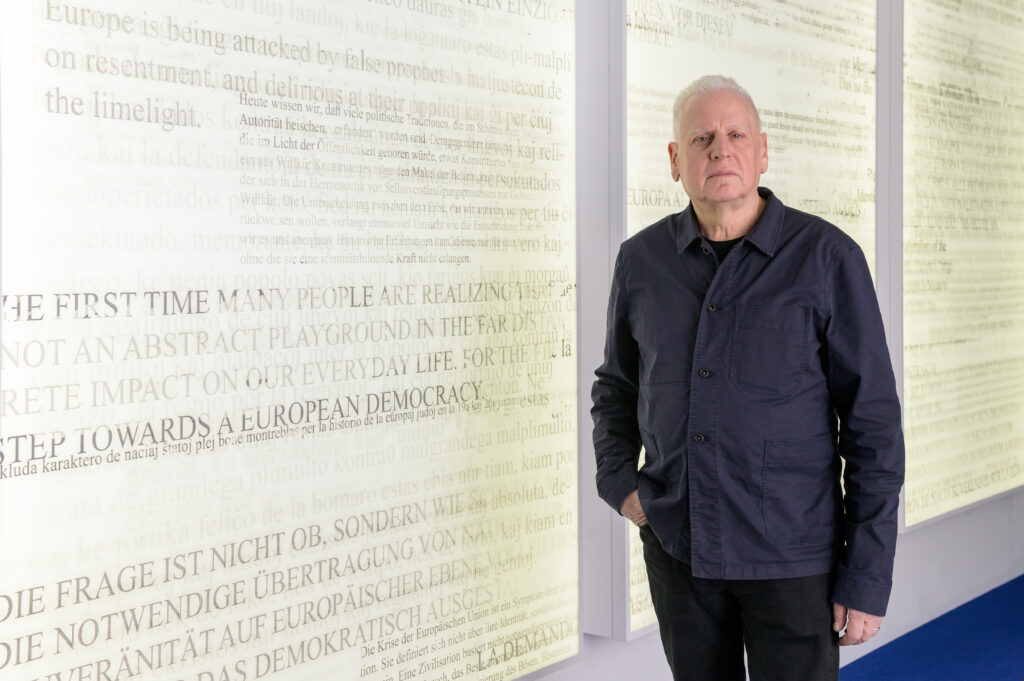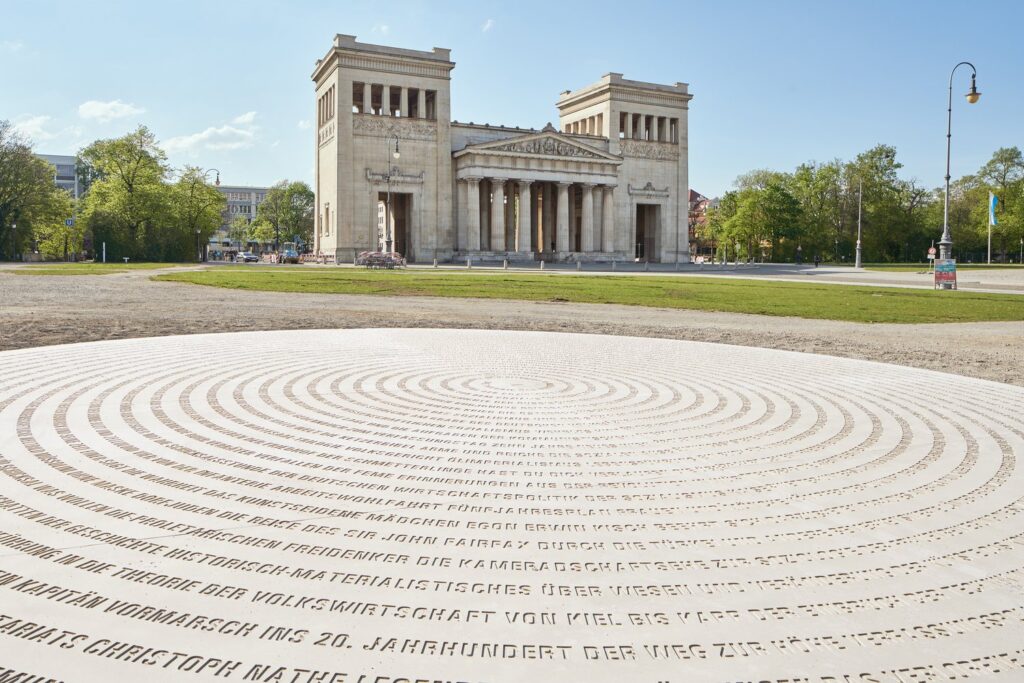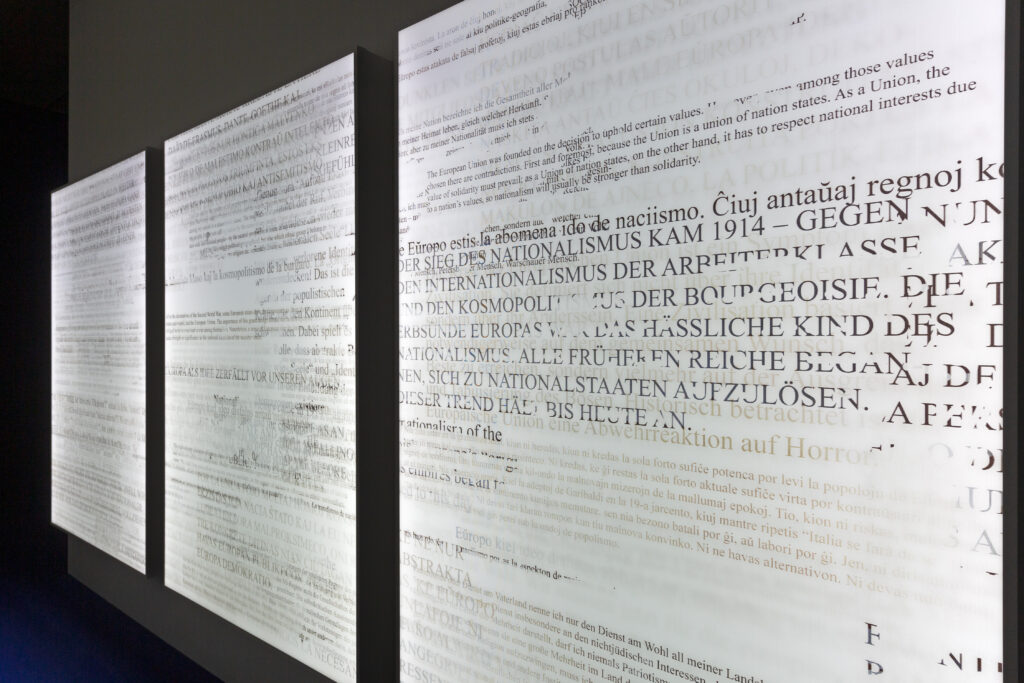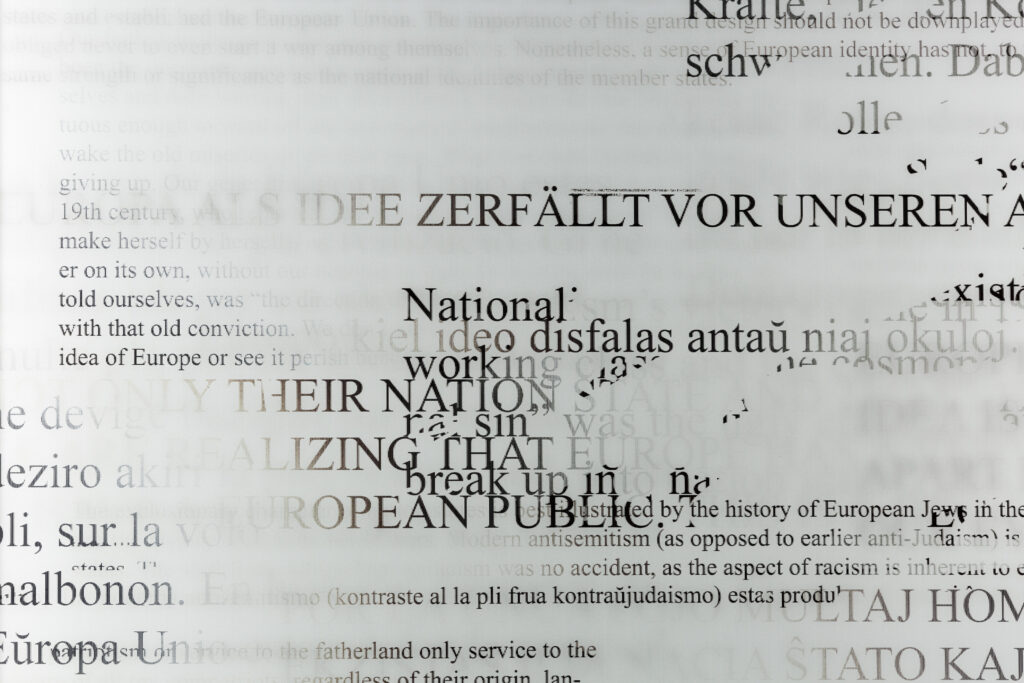
Arnold Dreyblatt, born in 1953 in New York City, lives and works as a media artist and composer in Berlin. In his works, he repeatedly deals with the themes of remembrance and forgetting. In 2021 he realized a memorial at Munich’s Königsplatz to commemorate the 1933 book burning. „The Blacklist / Die Schwarze Liste“ is a circular walkable artwork consisting of a concrete plate with the titles of 310 book titles whose authors were banned and publicly defamed by the National Socialists. The titles are arranged in a spiral, so that one must circle the artwork again and again in order to be able to read the titles.
For the exhibition „The Last Europeans. Jewish Perspectives on the Crises of an Idea“ at the Jewish Museum Munich, Dreyblatt has now created a new work. „Last Europeans?“ („Letzte Europäer?“) poses the question of a unifying European idea and looks at its ongoing threat from wars and nationalism. The text-based installation consists of three lenticular prints with quotes from European intellectuals in German, English and Esperanto. The special printing technique makes it possible to overlay several texts in such a way that different parts become visible from different perspectives and the textual polyphony can be experienced visually. We spoke with Arnold Dreyblatt about his new work.


Mr. Dreyblatt, the quotes in the installation „Last Europeans?“ come from Agnes Heller, Bernard-Henri Lévy, André Glucksman, Daniel Cohn-Bendit, Jaques Derrida and Jürgen Habermas, as well as the inventor of the planned language Esperanto, Ludwik Zamenhof. How did the selection of texts come about?
AD: These quotations were selected in collaboration with curator Felicitas Jelinek-Heimann. With the exception of Zamenhof, we searched for statements by European intellectuals, philosophers and activists who have reflected on the ongoing European crisis over the last years. These texts function as warnings of future conflict, right-wing, populist and totalitarian tendencies but they also reflect a grave personal disappointment in the collapse of enlightenment and liberal values, not only in Europe, but worldwide. Though the statements range in time from 2003 to 2019, they continue to be hauntingly relevant, especially resonating in dialog with the content of the entire exhibition.
„Last Europeans?“ is the first work in which you engage with Esperanto. The inventor of Esperanto, Ludwik Zamenhof, born in Białystok in 1859, hoped that a common „neutral-human“ language could help prevent wars and conflicts. What can we still gain from this utopia from today’s perspective?
AD: As I understood that I would include texts in the Esperanto language in the final work, I began to look more closely at Zammenhof’s own writings and was very surprised at the extent of his contextual structure in supporting the creation of this new language. I think that while we must continue to be critical in blindly accepting the call for new utopias, yest at the same time we must allow ourselves to be in a continual state of inspiration in relation to these historical moments. As the Jewish tradition writes (Pirkei Avot): “You are not obligated to complete the work, but neither are you free to desist from it.”

Similar to your work „The Blacklist / Die Schwarze Liste,“ the text in „Last Europeans? “ is only legible if you constantly change your point of view. Why did you decide on this form?
AD: Since living and working in Germany since 1984, my artistic practice has been preoccupied with the collection, visualization and vocalization of historical archival source material which refers and resonates to larger themes of memory, history, storage, preservation and cultural loss. For many years I have been fascinated by the perception of figure and ground in a textual field. I tend to present enormous amounts of textual material in my work which can never be grasped as a whole. Our perceptual apparatus needs a branch to hold onto, we grab a fragment, a name, or a phrase on a chosen layer which is then lost as we are forced to let go of that branch. We find ourselves in the forest again, but only until our attention roams again as we move actively in interaction with the work. It is this process of finding and loss, and the associations that connect these fragments, that forms the core of my practice.
Unlike in „The Blacklist,“ in your new installation there are always overlaps between the different text layers and gaps in the quotations. You describe this form as a palimpsest. Can this form be understood as a metaphor for a (fragmented) European memory?
AD: We live today within a cacophony of statements, positions and opinions in dialog with a rapidly receding collective historical consciousness. As the final statement in this exhibition, we arrive at a space for reflection and questioning where we have no answers, only fragments of lost chances and possible futures. I therefore decided to use lenticular technology to simulate this unstable textual field and force us to actively move one’s body and perceptual field to engage with fragments of these important texts.
The installation „Last Europeans?“ is on view until May 21, 2023 as part of the exhibition „The Last Europeans. Jewish Perspectives on the Crises of an Idea“ at the Jewish Museum Munich. On February 28, 2023, we cordially invite you to a panel discussion with Arnold Dreyblatt and the curators Dr. Felicitas Heimann-Jelinek and Dr. Michaela Feurstein-Prasser.
